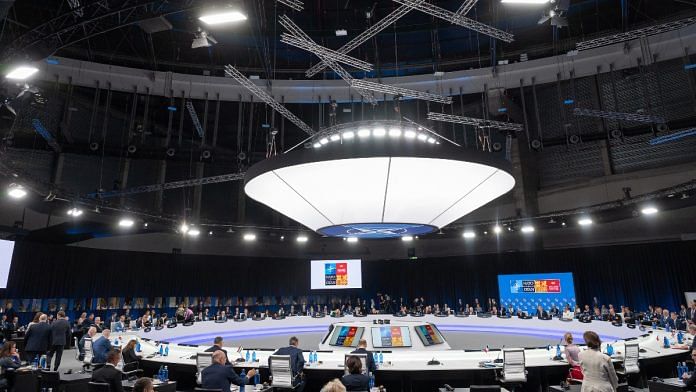New Delhi: The North Atlantic Treaty Organization (NATO) could struggle to fulfil its fresh commitment to push back against the People’s Republic of China, reveals data on defence expenditure by member states published by NATO and analysed by ThePrint.
According to the 2022 Strategic Concept, a policy document adopted at the NATO leaders’ summit held in Madrid in the last week of June, the military alliance believes that China’s “stated ambitions and coercive policies challenge” the “interests, security and values” of member states.
The policy document adds: “The PRC’s malicious hybrid and cyber operations and its confrontational rhetoric and disinformation target Allies and harm Alliance security. The PRC seeks to control key technological and industrial sectors, critical infrastructure, and strategic materials and supply chains.”
However, the Strategic Concept declares Russia to be the most “most significant” and “direct” threat to NATO.
While the policy document underlines the alliance’s intent as a unified bloc, there seems to be a mismatch between NATO’s bellicose posturing and defence spending by member states in recent years.
Data from NATO’s defence expenditure (2014-2022) report shows that excluding the United States, most European member states have failed to spend 2 per cent of GDP (Gross Domestic Product) on defence, a commitment they made 16 years ago.
This means that the majority of allies fall short of meeting the target. The 2 per cent is a floor pricing rather than a ceiling, leaving ample scope for states to spend more if they feel the need to do so.
According to the report, NATO member states, excluding the US, spent on average 1.64 per cent of GDP on defence in 2022, up marginally from 1.43 per cent in 2014.
Also Read: India has interests on both sides of US-China divide. Cold War holds clues for path ahead
Defence spending of Europe’s top 4
Germany, counted among the four major economies of Europe, has fallen short of allocating 2 per cent of its GDP to defence expenditure repeatedly since 2014. In 2014, Germany’s defence expenditure accounted for 1.19 per cent of GDP; it’s expected to be 1.44 per cent in 2022.
France has only met the 2 per cent threshold once since 2014, in 2020. Compared to 2014, when France’s defence spending accounted for 1.82 per cent of GDP, the figure is expected to touch 1.90 per cent in 2022.
Italy, too, has repeatedly fallen short of meeting the 2 per cent threshold since 2014, when its defence expenditure accounted for 1.14 per cent of GDP. Estimates suggest that the figure is expected to climb to 1.54 per cent in 2022.
The United Kingdom has emerged as the only big European economy part of NATO to consistently meet the 2 per cent mark since 2014. In 2014, the UK’s defence expenditure accounted for 2.13 per cent of its GDP, and it’s expected to be 2.12 per cent in 2022.
China’s defence spending
On the other hand, data from the Center for Strategic & International Studies (CSIS), a Washington-based think tank, shows that China — NATO’s new-found adversary — increased its defence expenditure by 75.05 per cent to $229.5 billion in 2022, from $131.1 billion in 2014.
China’s defence spending, as a share of GDP, has hovered around the 2 per cent mark during this period.
In contrast, NATO member states (excluding the US) have collectively increased their defence expenditure by only 27.23 per cent, from $289.275 billion in 2014 to $368.045 billion in 2022.
While comparing defence spending by a whole bloc with that of a single country may pose methodological questions, it reflects a larger trend of reduced military expenditure in the West over the past few decades that many attribute to the “peace dividend” in a post-Cold War Europe.
NATO stronger than ever?
Speaking at the NATO leaders’ summit in Madrid last week, US President Joe Biden, alluding to Sweden and Finland’s impending membership of the military alliance, had said that NATO would be “stronger than ever” with the induction of the two countries.
NATO leaders also decided on two more key measures that reflect the alliance’s increased commitment and unity as a bloc: a seven-fold increase in the number of NATO troops on high alert and the decision to set up a permanent base for American boots in Eastern Europe.
These measures fit into a larger narrative that Russia’s invasion of Ukraine has united NATO in a manner not seen since the days of the Cold War. But this unity does not reflect in military expenditure by NATO member states.
Speaking at a conference ahead of the leaders’ summit in Madrid last week, NATO Secretary-General Jens Stoltenberg had explained that only nine allies “have reached or exceeded the 2 per cent” threshold for defence expenditure in the year 2022.
Stoltenberg added that “19 allies have set a target of reaching the benchmark by 2024”, while five more member states have pledged to fulfil their commitment after 2024.
With a direct knock-on effect of the war in Ukraine prompting a sudden increase in defence budgets across Europe, it remains to be seen whether NATO states will fulfil the commitments that found mention in Stoltenberg’s address.
(Edited by Amrtansh Arora)
Also Read: Why Turkey’s rise in Russia-Ukraine war is a masterclass in balancing, hedging strategy



